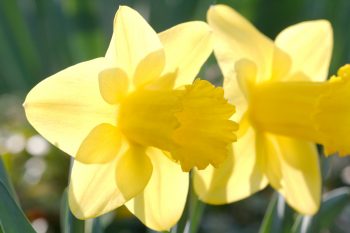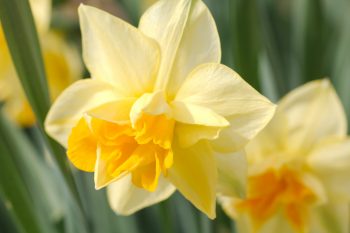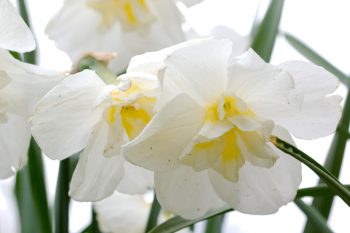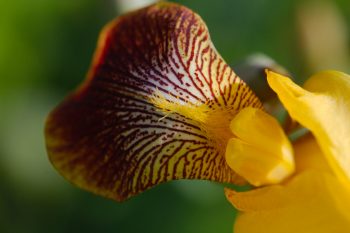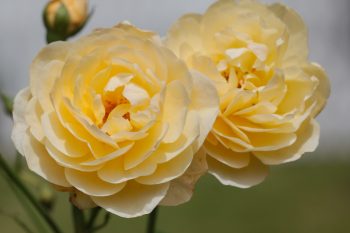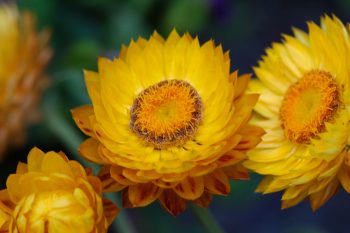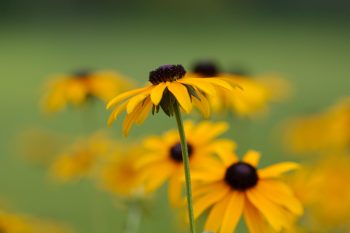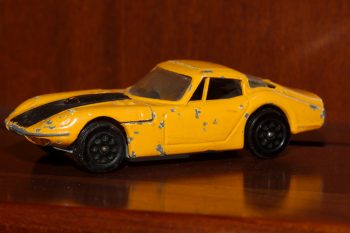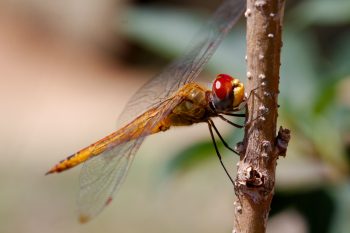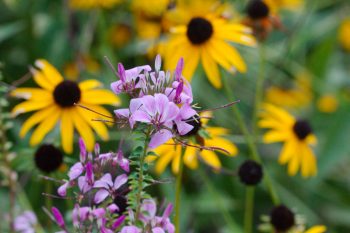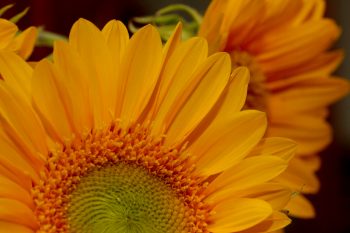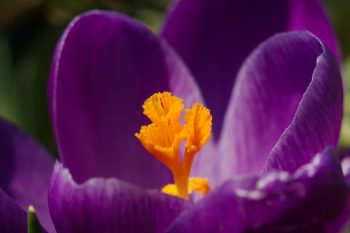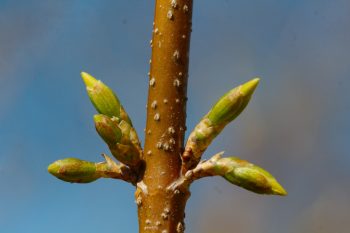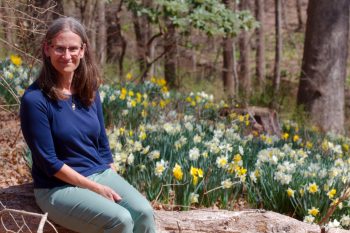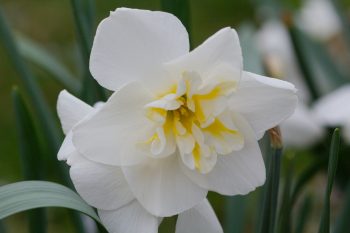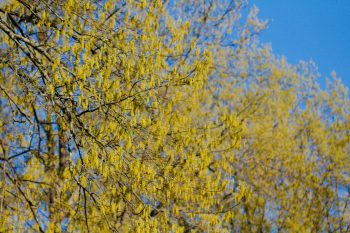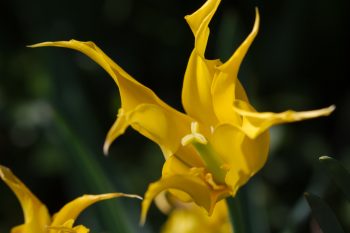I hope you’re enjoying the spring flowers. I know some of my followers are in the south and your flowers started earlier and your daffodils may be finished by now. Others are to the north and the daffodils are only just getting started. The early dafs are done here but there are quite a few still in full bloom and one or two that are yet to come. This is a large, bright yellow daffodil called ‘Arkle’ that I planted in the fall of 2014. This being only their fourth year here, they are not as well established as the very similar ‘Marieke’ planted five years earlier. Still, they’re putting on quite a show.
Tagged With: Yellow
Another Daffodil
The is the other of my unknown daffodil varieties. Like the one pictured three days ago, these bulbs were given to me by a friend and I didn’t make note of the variety name. They were planted in the fall of 2006 and are doing quite well. This particular variety, unfortunately, has a bad habit of not always opening. Also, when they do, as they mostly did this year, if it rains the flowers are too heavy for the stalks and they all droop. But when they are open and upright, they are quite nice. I was happy we got to enjoy them at their best this year.
Narcissus ‘Lemon Beauty’
The daffodils are generally past their peak but there are a few that are still going strong. These pretty, mostly white daffodils, called ‘Lemon Beauty’ are later than some and still look quite good. I planted them in the fall of 2014 and they seem to have settled in well enough. They are on the western side of a bed that is around a nearly dead Colorado spruce (Picea pungens). I need to cut the tree down and replace it with something more ornamental (and what isn’t more ornamental then a mostly dead spruce?). But the daffodils can stay, of course. I bought these bulbs from John Scheepers. Their description of this variety, is:
Lemon Beauty is a rapturous 4″ Lefeber Papillion-type with a bright ivory-white perianth accented by a radiant, star shaped lemon-yellow heart. Narcissus Class: Split-Cup Papillon (Royal Horticultural Society Division 11). Bulb size: 14/16 cm. April. 16″. HZ: 4-8.
Yellow Iris
A few days ago I mentioned that we had two varieties of large, bearded iris in our garden. The one photographed then was purple and white. This is a detail of the other one, which is mostly yellow with brown falls (as you can see). They are not quite as large as the purple and white flowers but are still quite striking. This one is growing just inside the fence to the back yard. Well, what’s left of the fence. It’s an old post and rail fence and the wood is rotting and it’s falling down. A few weeks ago I took down the better part of it and I’ll probably finish the job before too long.
Rose ‘Graham Thomas’
After mom’s brief stay ib the hospital, she had a few follow-up appointments, starting this morning. I thought it would be good to stay with her the rest of the day and because I can work remotely, that’s what I did. I took a short break in the early afternoon and took a few pictures in her yard. I also took some of her neighbor’s roses. This rose is called ‘Graham Thomas’, bred by David Austin, 1983. It is named for Graham Stuart Thomas OBE (April 3, 1909 – April 17, 2003), the famed British botinist, garden designer and rosarian.
Everlasting Flower
It’s been a busy week but I managed to get out onto the driveway with my camera this evening. It isn’t a long walk, after all. We have a little, yellow Stella d’Oro day lily in bloom just outside the front door, and I took pictures of that, first. Then I got a few pictures of the flowers on an Egyptian Walking Onion that self seeded from those in the back yard into one of the pots on the top of the driveway. Finally, I took pictures of this everlasting flower, Xerochrysum bracteatum ‘Sundaze Golden Beauty’. It’s certainly bright and as the name suggests, the flowers last. It’s a tender annual native to Australia but they do pretty well here, if given full sun and blooms pretty reliably all summer and well into the fall.
Black-eyed Susan
The 25 or so Rudbekia species are all native to North America and Rudbeckia hirta is the state flower of Maryland. We actually have two related varieties of black-eyed Susans in our yard and I don’t know if they are different species or different varieties of the same species. This is by far the more aggressive of the two and left to itself would probably take over the entire yard. In fact, even with some efforts to contain it, it’s taking over the entire yard. On the other hand, there isn’t a lot else blooming right now and if you look into our back yard, it’s filled with yellow, so I can’t really complain. This year, the garden has pretty much had to find for itself. Hopefully we’ll be able to do something with it next year.
Rudbekia
Here’s another photo of the black-eyed Susans in our back yard. After work today I sat in the back yard for a while. I decided it was time I cut my hair so I got the clippers out and did it. It was very hot and the hair stuck all over me but it’s done. While I was sitting after getting my hair cut, I enjoyed the black-eyed Susans that surround our patio. They have gotten somewhat out of control but they are lovely and if anything is going to go wild, it might as well be pretty. This is a time of the summer when there isn’t a lot else in bloom and the Rudbekia are quite welcome. Maybe next year we’ll have time to fight them back a little but for now, we’ll just enjoy their abundance.
Corgi Toys Marcos 3 Litre
I didn’t have any pictures today so I looked around for something to photograph. I have this little, yellow, model car that has been one of two sports cars I’ve owned over the years. I’m not saying that these are models of cars that I’ve actually owned. It’s the models that I’ve owned. The other is an old Jaguar XJ-S that was originally silver but I very carefully repainted a deep, lustrous green. This car, also British, could use a coat of paint. Somehow this is more in keeping with our current fleet, however. Our newest car is 13 years old, our middle car can vote, and our oldest can drink. They have a combined mileage of over 650 thousand miles. That’s not counting the miles on this little baby.
Wandering Glider (Pantala flavescens)
In a rare turn for late August, it was very pleasant outside today. The high probably wasn’t over about 82°F and it wasn’t humid at all. In the shade it was quite comfortable. To capitalize on such a nice day, Cathy and I met and took a walk around our company campus. Almost immediately when I went outside, I spotted this dragonfly, which I believe to be a wandering glider (Pantala flavescens), one of the skimmers. That ID may be wrong, but nevertheless, it’s a beautiful thing, with its dark yellow markings and striking red eyes.
Cleome and Black-eyed Susan
We really should plant more of this. The pink flowers in the foreground are Cleome ‘Señorita Rosalita’ and they really are lovely. They also bloom pretty much continuously all summer and well into the fall. We have just a few plants growing in a container on the back patio. They are pretty much overwhelmed by the yellow of the black-eyed Susans that are all around. I think if we had a larger container or two filled with Cleome, it would be pretty nice. I should make a point of buying a few packets of next year and getting them started early.
Black-eyed Susan
I took some pictures of skippers on black-eyed Susan flowers this evening. I also got a few decent shots of a little leaf hopper, which I haven’t identified. They are quite small and this one was probably only about 5mm long. There are about 3,000 described species in north America along and it is estimated that there are more than 100,000 species worldwide, with less than a quarter actually having been described. I decided to post this picture, instead of one with an insect, just because I like the shallow depth of field on the yellow petals of the black-eyed Susan.
Sunflowers
These were given to Margaret for her 92nd birthday and are quite pretty. We have them in a tall, blue vase that we were given as a wedding present and they are photographed here in front of the cherry china cabinet that I’ve used as a backdrop a few times since we moved it to our dining room. Sunflowers are great, not just because they last so long in a vase, but that certainly is a useful trait. Their combination of ray petals and the small flowers that make up the center of the flower head are just really pretty. And the color is nice, too.
Crocus
The so-called Dutch crocus (Crocus vernus and its cultivars) is native to the mountains of Europe, the Pyrenees, Alps and Carpathians. The name crocus comes from krokos (κρόκος) the ancient Greek name for saffron (Crocus sativus). While crocuses prefer gritty, well-drained soils they do amazingly well in our heavy, clay soil that is totally water logged all winter most years. This one is growing in a bed of lily of the valley (Convallaria majalis) and Vinca minor in our back yard. There are also some daffodils and hyacinths that are starting to come up bu those won’t be in bloom for a little while yet.
Forsythia Buds
The forsythia is starting to bud. As I write this, a week after the photo was taken, the buds have opened and the flowers are out. Spring can move quickly at times and when we have a warm spell, as we do at some point most years, buds open quickly. We often then have a frost that can kill back some of the more tender plants a bit. The early flowering star magnolia, with its fleshy, succulent petals, is generally one of the hardest hit. Other plants, like most early bulbs, the Lenten rose, and the forsythia, are better able to cope with a little cold, and generally just stop briefly, only to continue once it warms back up.
Cathy and Daffodils
After church this week, for the third week in a row, we walked over to the Stadtman Preserve to see the bulbs. The daffodils are pretty spectacular and entire sections of hillside are yellow with them. The Chionodoxa is still in bloom and there are areas completely dotted with their pretty, blue flowers. I took pictures of Cathy in a few different spots but I had only brought one lens, the 100mm, which wasn’t really idea for that sort of portraiture. This one turned out pretty well, though. Spring it definitely here and we’re loving it.
Cathy and Daffodils
This was our fourth Sunday in a row to enjoy the flowers at the Stadtman Preserve. Don’t be too surprised if we’re there again next week. Since daffodils only last so long, I’m going to continue to post pictures while the do. In addition to hundreds of daffodils of many sorts and shades of yellow and orange, the P.J.M. Rhododendrons are really starting to bloom. We also found one bloodroot plant (Sanguinaria canadensis) with a few blossoms. There were spring beauties (Claytonia virginica) and cut-leaved toothwort (Cardamine concatenata) and a few mayapples (Podophyllum peltatum).
Narcissus ‘Lemon Beauty’
The daffodils are about at their peak right now and will soon begin to fade. We have a few that are still getting ready to bloom for for the most part, they are open. These ‘Lemon Beauty’ daffodils were planted in the fall of 2014 so this is their fifth spring and they are doing quite well. They were planted in the bed around the Colorado spruce and were somewhat shaded by that but now that it’s gone, they’ll get more early spring sun, which they will appreciate, I suspect. The stump of the spruce is still there and I need to finish getting that up and then decide what to plan in its place. I’ve narrowed it down to a half dozen flowering trees but making the final decision is hard.
Flowering Oaks
There are trees we generally think of as flowering trees, such as dogwoods, cherries, and crab apples. But of course, most non-coniferous trees bloom, even if that’s not why we grow them. Out neighborhood has street trees planted pretty much throughout with different streets and different sections having different tree species but mostly planted with the neighborhood was developed in the late 1960s. Our area has mostly red oaks and at nearly 50 years old, they are generally pretty good size. Oaks are among those not usually grown for their showy flowers. Nevertheless, when they are in full bloom, particularly on a clear day in contrast with the blue sky, they are quite dramatic. Of course, the pollen is everywhere and if you have allergies, you aren’t enjoying this. But it can be beautiful.
Tulipa acuminata
The fireflame tulips (Tulipa acuminata) are coming into bloom. These interesting tulips are listed as species but they are not actually known in the wild and are probably some very old hybrid whose origin is lost in the mists of time. Either way, they are quite beautiful, with the pointed petals. They generally have mostly red petals with yellow towards the base but this variety, from McLure and Zimmerman, are almost entirely yellow with a little green running down the spine of the petals. Every year I wonder if they will come up and so far, they’ve not let me down.

